Mid Atlantic Healthcare
Issue date: 20th October 2020
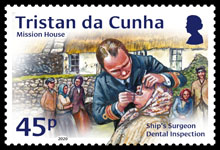 |
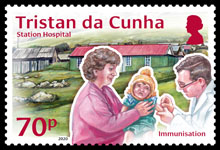 |
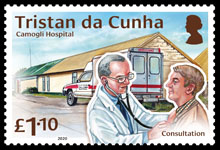 |
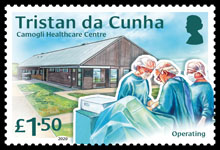 |
| 202009 | Mint Stamps (45p, 70p, £1.10, £1.50) | £3.75 |
| 202010 | First Day Cover (with 45p, 70p, £1.10, £1.50 stamps) | £4.75 |
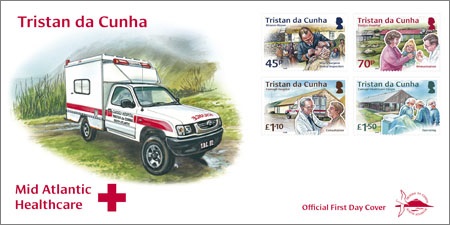
Description
Health is on everyone's minds during the current coronavirus pandemic, with people around the world spontaneously showing support for their local healthcare systems and staff. Thanks to timely precautions, COVID-19 has not reached Tristan da Cunha, and we pray this continues to be the case. Even so, we issue this set of stamps in appreciation of the island's own healthcare services.
Over the years, Tristan's healthcare has dramatically changed and improved, from having no medical professionals on the island and only being treated when a ship's doctor visited, to having a modern operational Healthcare Centre. These stamps illustrate the history of healthcare on Tristan.
45p - Mission House
In the beginning, the community on Tristan had no hospital or resident doctor. From the 1850s, missionaries, sent out by the Society for the Propagation of the Gospel (SPG), brought with them medical supplies and provided some medical care for mostly minor conditions. Ships' doctors or expeditions' doctors and dentists, in particular the doctors on Royal Navy ships, would check the health of the islanders during their visits and treat more serious cases, where possible. However, these visits occurred once a year or less frequently, and usually only lasted a couple of days. A few of these doctors published reports on the health of the islanders in the British medical press. These were mostly favourable, and in particular, the islanders gained a reputation for their healthy teeth, which was put down to the community's isolation and the low amount of sugar in the island diet at that time.
The first extended medical presence was during the three-month Norwegian Scientific Expedition to Tristan da Cunha in 1937/38. The three-strong medical team thoroughly examined every islander and provided some professional medical treatment, although the current missionary still dealt with day-to-day care.
70p - Station Hospital
During WWII, the naval station HMS Atlantic Isle was set up on Tristan, under the command of Surgeon Lieutenant Commander Woolley. New buildings were constructed, including for the first time a purpose-built school, store and hospital known as ‘Station Hospital'. The change in the island economy brought by the establishment of the first fishing factory in 1949/50 enabled the hospital to become a permanent fixture.
In the beginning, only a trained expatriate nurse was employed to provide medical services. Over time, the main equipment obtained for the hospital included a portable x-ray machine, a Boyle anesthetic machine, a microscope, and a reasonably comprehensive set of surgical instruments. Facilities for sterilization consisted of a paraffin pressure stove for boiling a saucepan of water and a domestic paraffin oven for baking towels, gowns, dressings, etc.
By 1961 Dr Norman Samuel reported that there were four beds in the hospital but no bathroom, and the operating-theatre was a room used as a thoroughfare and store-room. Just prior to the 1961 volcanic eruption and evacuation, another room was converted for use as a theatre, but was never used. At that time, the Colonial Office provided limited funds to cover drugs, day-to-day requirements such as paraffin and soap, as well as instruments, gloves, x-ray films, cleaners' salaries, and laundry.
£1.10 - Camogli Hospital
In 1971, a new hospital was built at the west end of the Settlement near Hottentot Gulch to replace the ‘Station Hospital'. It was named Camogli Hospital, after the hometown of the Italian settlers Andrea Repetto & Gaetano Lavarello who were wrecked on Tristan in 1892. The hospital had three inpatient beds, a consulting room, a pharmacy, X-ray facilities, a dental surgery and a well-equipped operating theatre. In the beginning, local nurses and a local dental nurse assisted the resident medical officers, who served for one or two years. In recent times, a local hospital manager and dental assistant were added to the medical team.
A dentist and dental technician visit the island annually and check and treat all the islanders' teeth with the assistance of the island dental nurse. An optometrist visits the island every second year and all the visiting specialists are available to discuss problems by telephone at other times.
It is a challenge to maintain an adequate, in-date pharmacy stock and to cover unpredictable demands, and allow for the possible failure of supply from any of the eight ships per year from Cape Town.
UK people may be interested to know that Doctor Hilary Jones, the medical broadcaster and Good Morning Britain TV presenter was Tristan's medical officer for a year in 1979. He has referred to his time on Tristan as "one of the most interesting stages of my career and a quite unique experience".
£1.50 - Camogli Healthcare Centre
The Camogli Healthcare Centre was officially opened on 7th June 2017. It was constructed, in the south-western corner of the settlement below the previous hospital, to the latest UK National Health Service standards. This was funded by the UK Department for International Development (DFID) with the intention that the improved facilities would allow more procedures to be performed locally by visiting specialists, and therefore reduce the need for expensive referrals to Cape Town.
At present, there are two expatriate doctors on the island, who provide 24-hour cover. They often return to Tristan for further terms of duty. There are also normally two expatriate and four local nurses, as well as a dental nurse and assistant, a hospital manager and ancillary staff. The medical staff deal with day to day medical matters, handle emergency cases, and undertake minor surgery. More complex and serious cases are sent to Cape Town for treatment.
FDC - Ambulance
The ambulance arrived on Tristan da Cunha 2003. It is fully functional, with all the medical equipment needed to respond to an emergency. It is also used to collect patients if they need assistance or do not have transport to attend their doctors' appointments.
Technical Specifications from Pobjoy Mint Ltd.
| Designer: | Robin Carter | ||
| Printer: | bpost | Stamp size: | 42.02 x 27.66mm |
| Process: | Lithography | Perforation: | 11½ per 2cms |
| Production Co-ordination: | Creative Direction (Worldwide) Ltd | Sheet format: | 10 |
